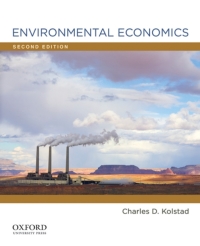A classic way of introducing pollution regulation into an urban area is the rollback method. First you
Question:
A classic way of introducing pollution regulation into an urban area is the "rollback" method. First you determine the maximum tolerable level of a particular pollutant, \(x_{\mathrm{s}}\). Next you find the maximum current concentration of that pollutant in the urban area, \(x_{\mathrm{m}}\). Presumably \(x_{\mathrm{m}}>x_{\mathrm{s}}\) (otherwise, there is no problem). Regulations then require all polluters in the city to reduce emissions from their current level of \(e_{\mathrm{m}}\) to \(e_{\mathrm{s}}=e_{\mathrm{m}}\left(x_{\mathrm{s}} / x_{\mathrm{m}}\right)\). Explain how this would work to bring pollution levels down to an acceptable point. What might be the efficiency problems with such an approach?
Fantastic news! We've Found the answer you've been seeking!
Step by Step Answer:
Related Book For 

Question Posted:





